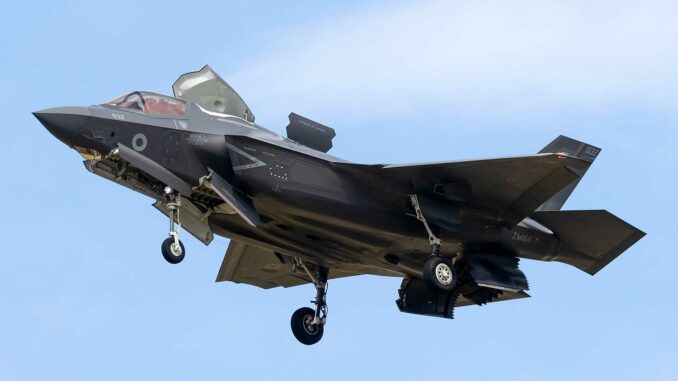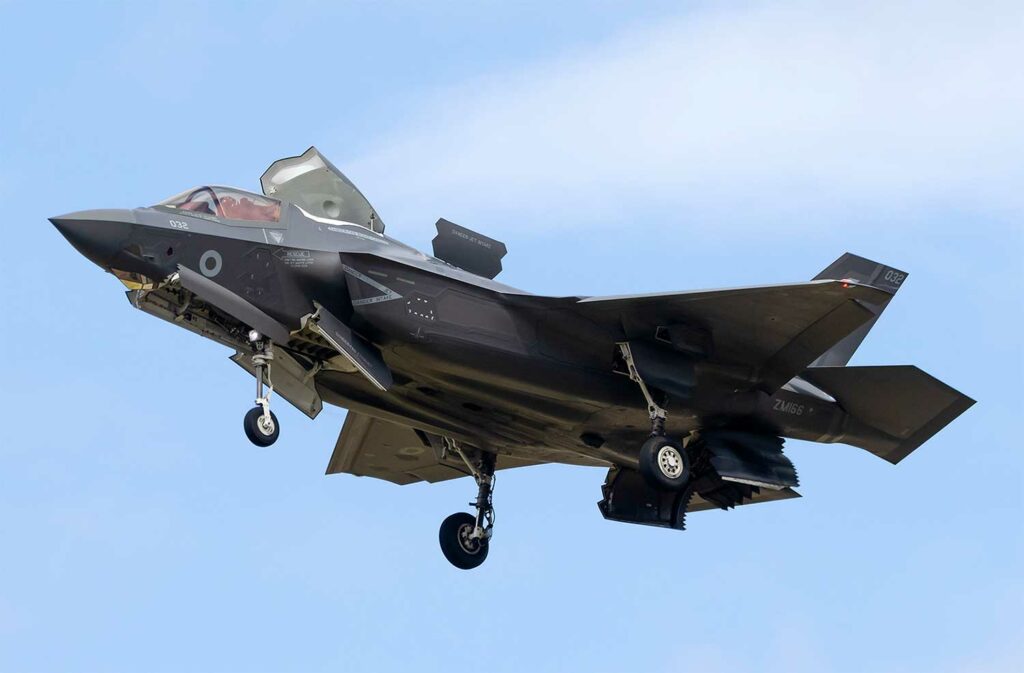
A modified $12.5 billion contract finalizes batch 18 and launches batch 19 of the F-35s. Breakdown by variant, operational implications, and supply chain.
Summary
The U.S. Department of Defense has awarded Lockheed Martin a $12.5 billion contract modification covering the production and delivery of 148 F-35s. The act “finalizes” Lot 18 and adds scope to Lot 19, for a total of 296 aircraft across both lots. The breakdown includes 40 F-35As for the U.S. Air Force, 12 F-35Bs and eight F-35Cs for the U.S. Marine Corps, nine F-35Cs for the U.S. Navy, 13 F-35As and two F-35Bs for partner nations, and 52 F-35As and 12 F-35Bs under FMS sales. The contract structure combines fixed-price incentive, firm-fixed-price, and cost-plus-fixed-fee elements to share the risk between the manufacturer and the buyer depending on the nature of the work. Operationally, the agreement consolidates the US and allied fleets, while securing the program’s global supply chain and supporting the ramp-up after the Tech Refresh 3 upgrade. The first deliveries of the Lot 18-19 cycle are expected to begin in 2026, with specific measures to prevent supplier obsolescence.
The contract and its scope
The decision and financial scope
The modified contract is worth approximately $12.5 billion for 148 aircraft and is linked to a previous package announced at the end of 2024 (~$11.8 billion), bringing the aggregate value of Lots 18-19 to nearly $24.3 billion and 296 aircraft. This “definitization” brings an end to negotiations that began in 2023 and sets the parameters for costs, deadlines, and responsibilities. Deliveries will begin in 2026, with final assembly concentrated in Fort Worth, Texas, supported by FACO lines in Cameri, Italy, and Nagoya, Japan, for certain customers.
Contract mix and risk sharing
Three regimes apply: fixed-price incentive (incentives for cost/performance compliance), firm-fixed-price (fixed price on mature lots), and cost-plus-fixed-fee (cost reimbursed + fixed remuneration for tasks with higher uncertainty, e.g., engineering) . This mix makes it possible to lock in the price of stabilized airframes and subassemblies, while maintaining flexibility for technical developments or long-lead purchases subject to supply uncertainties.
Breakdown by customer and variant
The needs of the US forces
The breakdown on the US side reflects mission profiles. The US Air Force is receiving 40 F-35As to supplement its air superiority/interdiction squadrons and maintain an alert posture in multiple theaters. The US Marine Corps is taking 12 F-35Bs (STOVL) for carrier-based aviation on LHD/LHA and support for Marine Expeditionary Units, as well as eight F-35Cs for long-range carrier-based operations. The US Navy is adding nine F-35Cs to reinforce its carrier-based fixed-wing aircraft, capable of catapult launches and arrestor landings.
FMS partners and customers
The international component includes 13 F-35As and two F-35Bs for program partners (cooperative partners), as well as 52 F-35As and 12 F-35Bs for FMS customers. This allocation meets national entry-into-service schedules, NATO standardization, and fleet renewal needs in Europe and Asia-Pacific. It confirms the F-35’s position as a shared operational standard, simplifying training, maintenance, and interoperability.
Operational implications
The rise of multi-domain effects
The package strengthens the critical mass of 5th generation aircraft available for air superiority, penetration, and precision strike. The F-35’s sensor-effect integration (data fusion, secure data link, electro-optical sensors) increases NATO interoperability and tactical situational awareness for the benefit of 4th and 4.5th generation fleets. In practice, this expands detection and deception “bubbles,” increases survivability in dense ground-to-air environments, and facilitates the segregation of roles between A, B, and C.
The schedule, TR-3, and Block 4
After delays related to Tech Refresh 3 (TR-3), the resumption of production and delivery of stored aircraft put the program back on track for 2025. The Block 4 upgrades, backed by TR-3, will continue into the early part of the next decade, with software and hardware increments to expand the range of weapons and sensor modes. The first Lot 18-19 deliveries are expected in 2026, an important milestone in stabilizing the production flow.

Supply chain and industrial capacity
Suppliers and final assembly lines
The F-35 relies on a sprawling supply chain with between 1,650 and more than 1,900 suppliers worldwide. Subassemblies are shipped to three final assembly and testing sites (Fort Worth, Cameri, Nagoya). This geographical dispersion supports resilience, but requires significant logistical coordination, buffer stocks, and careful management of obsolescence risks.
The F135 engines and the ECU
Pratt & Whitney’s F135 engine remains the powerhouse of the three variants. The Engine Core Upgrade (ECU) received full funding in FY2024 and is progressing, with technical milestones expected before entry into service towards the end of the decade. This project is key to maintaining the temperatures and thermal margins required by Block 4 capabilities, as well as to long-term sustainability.
Anti-shortage measures and DMSMS
In addition to the main contract, the Pentagon is funding targeted actions against shortages and diminishing manufacturing sources and material shortages (DMSMS), including advance purchases of exposed parts and electronic redesigns. The goal is to avoid bottlenecks that would slow down production and preserve cost/quality/lead time performance.
Budget allocation and pricing mechanisms
Orders of magnitude and cost structure
The flyaway unit value varies depending on the variant and batch. As a guide, recent references place the F-35A at around $82.5 million, the F-35B at around $109 million, and the F-35C at around $102 million, levels that are sensitive to inflation, TR-3/Block 4 content, and learning effects. The contract covers airframes, engines, parts, documentation, testing, and initial services. Economies of scale on Lots 18-19 volumes and stabilization of the supply chain are intended to keep the unit price increase below inflation.
Performance incentives
The fixed-price incentive scheme encourages the manufacturer to control costs and deadlines, while sharing gains/variances according to predefined formulas. Firm-fixed-price components lock in prices for mature elements (airframes, certain subsystems). Cost-plus-fixed-fee segments cover more uncertain work (engineering modifications, electronic board redesigns), without exposing the manufacturer to unlimited risk, but with pressure to report and audit costs.
Operational effects for forces and allies
Densification of the 5th generation fleet
For the US Air Force, the increase in the F-35A fleet supports its posture in Europe and the Indo-Pacific, the generation of QRA alerts, and advanced training. The US Marine Corps gains expeditionary flexibility with the F-35B (operations from short decks and rough runways), while strengthening carrier-based aviation with the F-35C. The US Navy increases the number of carrier-based stealth fighters, useful for penetration and defense suppression. FMS partners and customers, for their part, are consolidating a common base of doctrine, training, and support.
Interoperability and maintenance
F-35 standardization promotes NATO interoperability: common procedures, data exchange, and sharing of heavy maintenance and stocks. Regional centers (FACO, engine depots, parts hubs) reduce downtime and the logistical footprint in operations. The benefit can also be measured in terms of operational readiness, with simulators and mission software harmonized across fleets.
Areas for attention in the medium term
TR-3/Block 4 maturity
The delivery of TR-3 increments and the move to Block 4 will determine some of the promised performance (sensors, weapons, electronic warfare). Public audits have highlighted delays in 2023-2024 and the need to secure the software/hardware schedule and testing capacity. The 2025 indicators are improving, but the milestones leading up to full potential remain to be monitored.
Sustainability and ownership costs
Beyond the purchase price, technical availability, cost per flight hour, and supply chain robustness will determine actual operational performance. DMSMS measures, the F135 ECU, and digital investments in predictive maintenance must converge to stabilize availability rates and lower the 30-year support bill.
A contract that locks in capacity and industry
This batch of 148 F-35s secures a clear trajectory: critical mass for the forces, a transatlantic industrial base, and a better-defined technical and logistical roadmap. These aircraft now need to be converted into useful hours and operational effects through doctrine, training, and rigorous testing campaigns. The next step will be played out as much in the integration benches and engine depots as on the assembly lines, proving that a fifth-generation program is also won in the shadows of the supply chain.
War Wings Daily is an independant magazine.